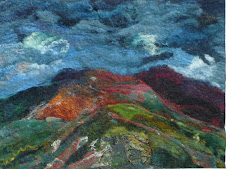 Posted by Helen
Posted by HelenJust before I went off to the Woolfest I ordered this book-daft of me because I probably could have got it there. It has just been published so on the principal that a dyer can't have too many books I got it as soon as I saw it mentioned on another blog.
Judy Hardman writes about the dyeing while Sally Pinhey produced the beautiful botanical illustrations. Judy chose plants (I counted 59) that you could either grow in the garden or can find easily growing wild ranging from Agrimony to Yew. The book is similar in lay out to Margaret and John Cannon's " Plants Dye Plants and Dyeing" published in association with Kew Gardens and illustrated by Greta Dalby Quenet. In both cases the text is on the left hand side while the botanical illustrations are on the right. However Judy Hardman has also added some photographs to her text and pictures of some beautiful fair isle knitting scattered throughout.
The plants are listed alphabetically according to their English name with the Latin name underneath.
Judy then tells you a little about the use of the plant in previous times, some fascinating bits of ancient lore before telling you how to dye with the plant. At the bottom of the page are samples of dyed wool using the traditional four mordants: alum,copper, tin and chrome.
Judy's explanation of preparation are concise and mostly easy to follow although I found her instructions on cotton scouring and mordanting a little confusing . She is also very clear on the risks attached to using copper and chrome although I could not find any mention of the fact that chrome-potassium bichromate is a carcinogen. I was disturbed to find that on page 20 on the section on scouring cotton she says to use 24% WOF (weight of fibres) washing soda/caustic soda,the first of course is sodium carbonate the second sodium hydroxide and a powerful alkali. It is possible that boiling cotton in 24% WOF of caustic soda would destroy the cotton. However I have corresponded with Judy and she say unfortunately the editing failed and this should have read washing soda/not caustic soda. There are one or two other editing errors-elsewhere she mentions 8%cream of tartar and7% Alum as a mordant (the figures have been reversed) but she tells me she has a page on her website listing all the errors and that can be found here at www.somborneshetlands.co.uk/errata.html
I disagreed quite fundamentally with her comment that that yarn dyed blue with woad or with Polygonum Tinctoria (now Persicaria Tinctoria) is likely to rub off on your hands as you knit because the indigotin is a contact dye. It may rub off but if it does it is because of faulty dyeing, a very common fault caused mostly by either over reduction or over heating of the vat. In this case the indigo white, the soluble form of indogitin, is too soluble and converts in the air too rapidly resulting in faulty bonding to the fibres. Here is link to Debbie Bamford blog on this very issue to prove my point!.
I was also a little baffled with her division of types of dyes into direct, mordant or substantive. Her definition of substantive dyes is that they are the vat dyes not as is normally defined dyes that will dye without an additional mordant. These dyes she appear to define as direct dyes.
What I like about the book is that Judy has plainly dyed with all the plants she mentions, and for example she is the first person I know who got colour from the roots of Iris Pseudocorus.
I love all the information about the plants, but I would have liked references to the primary sources and more about the dyes in the plants. However I like the fact she talks about solar dyeing, about dyeing for felting, and about lightfastness. She also has a large section at the back of the book devoted to a variety of layout for different types of dye garden including one for container gardens. I showed it to students attending a dyeing workshop on Saturday and they all were very enthusiastic about it especially two who are planning to have a dye garden.
It is a lovely book, a pleasure to have on my shelf and I was very glad, as I was about to chop meadowsweet for a solar bath while I had a glass of wine, to discover meadow sweet contained prussic acid so I deferred the chopping till after I had had my wine. Shame about the typos and the editing but it is rare to find a perfect book and this one will be a welcome addition onto a dyers shelf particularly for dyers interested in growing and gathering plants.
Natural Dyes by Judy Hardman and Sally Pinhey published by Crowood ISBN 978-1-84797-100-5



























Thank you Helen for this post, it is very informative!
ReplyDeleteThank you, Helen - it's great to hear about a dye book from someone who really the knowledge and experience to review it thoroughly! :)
ReplyDeletethank you for this excellent book review-Kathyinozarks
ReplyDeleteThank you for your comments and link to errata corrige.
ReplyDeleteI just purchased the book from Amazon and as soon as I receive it I will note all changes.
I was attracted by the possibility to learn about a dye garden layout and the use of some plants I often find when walking around.
Ciao from the Lake of Como (Italy)
Anna Maria
Hi Birci I am sure you will enjoy the book and will soon be planting your own dye garden,
ReplyDelete